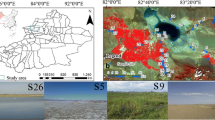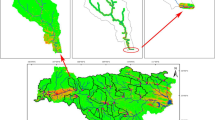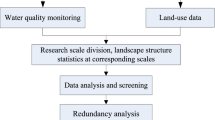Abstract
The composition and configuration of land uses/covers (LULC) have a key role in determining the quality of surface waters. This study investigated the relationships between 207 landscape metrics (LMs) at landscape and class levels and water quality parameters (WQPs) by analytically approach in Mazandaran sub-basins, north of Iran. For this purpose, at first the basic WQPs were identified by principal component analysis (PCA). Then, stepwise linear regression analysis was applied to recognize optimal LMs for estimating each of the WQPs individually. Finally, the effect of the spatial configuration of LULC classes on WQPs and their variability was analytically evaluated by real samples. According to the PCA results, SAR, TDS, pH, PO43−, and NO3− were identified as principal WQPs in Mazandaran Rivers. The results also showed that the interspersion and juxtaposition index of bare lands, related circumscribing circle of agriculture, percentage of the forest, connectivity index of residential, and percentage of agriculture were the optimal metrics for estimating SAR, pH, TDS, PO43−, and NO3− levels, respectively. The metrics at the class level also had more ability to describe the WQPs. In this study, a suitable model for future LULC establishment in Mazandaran Province with the aim of improving effects on surface water quality was proposed.













Similar content being viewed by others
References
Abdi H, Williams LJ (2010) Principal component analysis. Wiley Interdiscip Rev Comput Stat 2(4):433–459
Adams MA, Attiwill PM (1982) Nitrogen mineralization and nitrate reduction in forests. Soil Biol Biochem 14(3):197–202
Ahmadi T, Sheikhuleslami A (2003) The role of soil physical and chemical properties in pure stands of oak (Quercus castaneifolia) in Galandroud forest (west Mazandran state). J Pajouhesh Sazandegi 63:59–68 (In Persian with English Abstract)
Alberti M, Booth D, Hill K, Coburn B, Avolio C, Coe S, Spirandelli D (2007) Theimpact of urban patterns on aquatic ecosystems: an empirical analysis on Puget lowland sub-basins. Lands Urban Plan 80(4):345–361
Amiri BJ (2006) Modeling the relationship between land cover and river water quality in the Yamaguchi prefecture of Japan. J Ecol Field Biol 29(4):343–352
Amiri BJ, Nakane KA (2009) Modeling the linkage between river water quality and landscape metrics in the Chugoku district of Japan. Water Resour Manag 23(5):931–956
Bahar MM, Hiroo O, Masumi Y (2008) Relationship between river water quality and land use in a small river basin running through the urbanizing area of central Japan. Limnology 9(1):19–26
Burkart MR, James DE (1999) Agricultural-nitrogen contributions to hypoxia in the Gulf of Mexico. J Environ Qual 28(3):850–859
De Mello K, Valente RA, Randhir TO, dos Santos ACA, Vettorazzi CA (2018) Effects of land use and land cover on water quality of low-order streams in Southeastern Brazil: watershed versus riparian zone. CATENA 167:130–138
Gholamalifard M, ZareMaivan H, Joorabian Ss, Mirzaei M (2012) Monitoring land cover changes of forests and coastal areas of northern iran (1988–2010): a remote sensing approach. J Persian Gulf 3(10):47–56
Gholamalifard M, Joorabian Shooshtari S, Hosseini Kahnuj S, Mirzaei M (2013) Land cover change modeling of coastal areas of Mazandaran Province using LCM in a GIS environment. J Environ Stud 38(4):109–124
Griffith JA (2002) Geographic techniques and recent applications of remote sensing to landscape-water quality studies. Water Air Soil Pollut 138(1–4):181–197
Hashemi F, Olesen JE, Dalgaard T, Børgesen CD (2016) Review of scenario analyses to reduce agricultural nitrogen and phosphorus loading to the aquatic environment. Sci Total Environ 573:608–626
Hatt BE, Fletcher TD, Walsh CJ, Taylor SL (2004) The influence of urban density and drainage infrastructure on the concentrations and loads of pollutants in small streams. Environ Manag 34(1):112–124
Hively WD, Hapeman CJ, McConnell LL, Fisher TR et al (2011) Relating nutrient and herbicide fate with landscape features and characteristics of 15 sub watersheds in the Choptank river watershed. Sci Total Environ 409(19):3866–3878
Iqbal MS, Islam MM, Hofstra N (2019) The impact of socio-economic development and climate change on E. coli loads and concentrations in Kabul River Pakistan. Sci Total Environ 650:1935–1943
Jones KB, Neale AC, Nash MS, Van RD, Wickham JD, Riitters KH, O’Neill RV (2001) Predicting nutrient and sediment loadings tostreams from landscape metrics: a multiple watershed study from the United States Mid-Atlantic region. Landsc Ecol 16(4):301–312
Joorabian-Shooshtari S, Shayesteh K, Gholamalifard M, Azari M, López-Moreno JI (2018) Land cover change modelling in Hyrcanian forests Northern Iran: a landscape pattern and transformation analysis perspective. Cuad Investig Geogr 44(2):743–761
Lamine S, Petropoulos GP, Singh SK, Szabó S, Bachari NEI, Srivastava PK, Suman S (2018) Quantifying land use/land cover spatio-temporal landscape pattern dynamics from Hyperion using SVMs classifier and FRAGSTATS. Geocarto Int 33(8):862–878
Lausch A, Herzog F (2002) Applicability of landscape metrics for the monitoring of landscape change: issues of scale resolution and interpretability. Ecol Indic 2(1):3–15
Lausch A, Blaschke T, Haase D, Herzog F, Syrbe RU, Tischendorf L, Walz U (2015) Understanding and quantifying landscape structure—a review on relevant process characteristics data models and landscape metrics. Ecol Model 295:31–41
Lee SW, Hwang SJ, Lee SB, Hwang HS, Sung HC (2009) Landscape ecological approach to the relationships of land use patterns in watersheds to water quality characteristics. Landsc Urban Plan 92(2):80–89
Li X, Jongman RH, Hu Y, Bu R, Harms B, Bregt AK, He HS (2005) Relationship between landscape structure metrics and wetland nutrient retention function: a case study of Liaohe Delta China. Ecol Indic 5(4):339–349
Li K, Chi G, Wang L, Xie Y, Wang X, Fan Z (2018) Identifying the critical riparian buffer zone with the strongest linkage between landscape characteristics and surface water quality. Ecol Indic 93:741–752
Lowicki D (2012) Prediction of flowing water pollution on the basis of landscape metrics as a tool supporting delimitation of Nitrate Vulnerable Zones. Ecol Indic 23:27–33
Mahmoudi B, Hamidifar M, Khorasani N (2007) Study of land use change in Karkheh watershed and its role in physical and chemical quality of Karkheh River. In: Fourth national conference on watershed management sciences and engineering management of watersheds proceeding. https://www.civilica.com/Paper-WATERSHED04-WATERSHED04_022.html
McGarigal K, Cushman SA, Neel MC, Ene E (2002) FRAGSTATS: spatial pattern analysis program for categorical maps. In: Computer software program produced by the authors at the University of Massachusetts Amherst available at the following web site: https://www.umass.edu/landeco/research/fragstats/fragstats.html
Mehaffey MH, Nash MS, Wade TG, Ebert DW, Jones KB, Rager A (2004) Linking land cover and water quality in New York City’s water supply watersheds. Environ Monit Assess 107(1):29–44
Minareci O, Çakır M (2018) The study of surface water quality in Buyuk Menderes River (Turkey): determination of anionic detergent phosphate boron and some heavy metal contents. Appl Ecol Environ Res 16(4):5287–5298
Minick KJ, Pandey CB, Fox TR, Subedi S (2016) Dissimilatory nitrate reduction to ammonium and N2O flux: effect of soil redox potential and N fertilization in loblolly pine forests. Biol Fertil Soils 52(5):601–614
Mirzaei M, Riyahi-Bakhtiyari A, Salman-Mahini A, Gholamalifard M (2013) Investigating the land cover changes in Mazandaran province using landscape ecology’s metrics between 1984–2010. Iran J Appl Ecol 2(4):37–55 (in Persian with English Abstract)
Mirzaei M, Jafari A, Gholamalifard M, Azadi H, Shooshtari SJ, Moghaddam SM, Gebrehiwot K, Witlox F (2020) Mitigating environmental risks: Modeling the interaction of water quality parameters and land use cover. Land Use Policy 95:103766
Mirzayi M, Riyahi Bakhtiyari A, Salman Mahini A, Gholamalifard M (2014) Analysis of the physical and chemical quality of Mazandaran province (Iran) rivers using multivariate statistical methods. J Mazandaran Univ Med Sci 23(108):41–52
Mirzayi M, Riyahi Bakhtiyari A, Salman Mahini A, Gholamalifard M (2016) Modeling relationships between surface water quality and landscape metrics using the adaptive neuro-fuzzy inference system a case study in Mazandaran Province. J Water Wastewater 27(1):81–92
Moreno MD, Mander Ü, Comín FA, Pedrocchi C, Uuemaa E (2008) Relationships between landscape pattern wetland characteristics and water quality in agricultural catchments. J Environ Qual 37(6):2170–2180
Nakane K, Haidary A (2009) Sensitivity analysis of stream water quality and land cover linkage models using montecarlo method. Int J Environ Res Public Health 4(1):121–130
Nejatkhah-Manavi P, Pasandi AA, Saghali M, Beheshtinia N, Mirshekar D (2009) Study of nitrate and phosphate in eastern south Caspian Sea in spring and summer. J Mar Sci Technol Res 4(3):11–19 (In Persian with English Abstract)
Ngoye E, Machiwa JF (2004) The influence of land-use patterns in the Ruvu river watershed on water quality in the river system. Phys Chem Earth 29(15):1161–1166
Noori R, Sabahi M, Karbassi A, Baghvand A, TaatiZadeh H (2010) Multivariate statistical analysis of surface water quality based on correlations and variations in the data set. Desalination 260(1):129–136
Norton M, Fisher T (2000) The effects of forest on stream water quality in two coastal plain watersheds of the Chesapeake Bay. Ecol Eng 14(4):337–362
Ouyang Y (2005) Evaluation of river water quality monitoring stations by principal component analysis. Water Res 39(12):2621–2635
Powley HR, Durr HH, Lima AT, Krom MD, Van Cappellen P (2016) Direct discharges of domestic wastewater are a major source of phosphorus and nitrogen to the Mediterranean Sea. Environ Sci Technol 50(16):8722–8730
Riitters KH, Hunsaker CT, James DW, Yankee DH, Timmins SP, Jones KB, Jackson BL (1995) A factor analysis of landscape pattern and structure metrics. Landsc Ecol 10(1):23–39
Salajegheh A, Razavizadeh S, Khorasani N, Hamidifar M, Salajegheh S (2011) Land use changes and its impacts on river water quality. J Environ Stud 37(58):81–86 (In Persian)
Schoonover JE, Lockaby BG (2006) Land cover impacts on stream nutrients and fecal coliform in the lower Piedmont of West Georgia. J Hydrol 331(3–4):371–382
Shi P, Zhang Y, Li Z, Li P, Xu G (2017) Influence of land use and land cover patterns on seasonal water quality at multi-spatial scales. CATENA 151:182–190
Shrestha S, Kazama F (2007) Assessment of surface water quality using multivariate statistical techniques: a case study of the Fuji river basin, Japan. Environ Model Softw 22(4):464–475
Tafangenyasha C, Dube LT (2008) An investigation of the impacts of agricultural runoff on the water quality and aquatic organisms in a Lowveld Sand river system in Southeast Zimbabwe. Water Resour Manag 22(1):119–130
Talebi-Amiri S, Azari-Dehkord F, Sadeghi SH, Soofbaf SR (2009) Study on landscape degradation in Neka watershed using landscape metrics. J Environ Sci 6(3):133–144 (in Persian with English Abstract)
Tiwari S, Mandal NR, Saha K (2018) A geospatial analysis of anthropogenic activities and their impacts on river Narmada. Available at SSRN 3214250
Tong ST, Chen W (2002) Modeling the relationship between land use and surface water quality. J Environ Manag 66(4):377–393
Turner RE, Rabalais NN (2003) Linking landscape and water quality in the Mississippi River Basin for 200 years. Bioscience 53(6):563–572
Udeigwe TK, Wang J, Zhang H (2007) Predicting runoff of suspended solids and particulate phosphorus for selected Louisiana soils using simple soil tests. J Environ Qual 36(5):1310–1317
Uuemaa E, Roosaare J, Mander Ü (2005) Scale dependence of landscape metrics and their indicatory value for nutrient and organic matter losses from catchments. Ecol Indic 5(4):350–369
Wilson C, Weng Q (2010) Assessing surface water quality and its relation with urban land cover changes in the Lake Calumet area Greater Chicago. Environ Manag 45(5):1096–1111
Wold S, Esbensen K, Geladi P (1987) Principal component analysis. Chemom Intell Lab Syst 2(1–3):37–52
Wu MY, Xue L, Jin WB, Xiong QX, Ai TC, Li BL (2012) Modeling the linkage between landscape metrics and water quality indices of hydrological units in Sihu basin Hubei Province China: an allometric model. Procedia Environ Scie 13(1):2131–2145
Yan X, Liu M, Zhong J, Guo J, Wu W (2018) How human activities affect heavy metal contamination of soil and sediment in a long-term reclaimed area of the Liaohe River Delta North China. Sustainability 10(2):338
Yang X (2012) An assessment of landscape characteristics affecting estuarine nitrogen loading in an urban watershed. J Environ Manag 94(1):50–60
Acknowledgements
The authors thank employees of Iran Water Resources Management Organization for their kind cooperation. Mohsen Mirzaei was supported by the Iran National Science Foundation (INSF) (grant agreement: 98018616).
Author information
Authors and Affiliations
Corresponding author
Additional information
Editorial responsibility: Zhenyao Shen.
Rights and permissions
About this article
Cite this article
Mirzaei, M., Jafari, A., Riyahi Bakhtiari, A. et al. Configurationally analysis of relationships between land-cover characteristics and river water quality in a real scenario. Int. J. Environ. Sci. Technol. 18, 1877–1892 (2021). https://doi.org/10.1007/s13762-020-02964-x
Received:
Revised:
Accepted:
Published:
Issue Date:
DOI: https://doi.org/10.1007/s13762-020-02964-x




